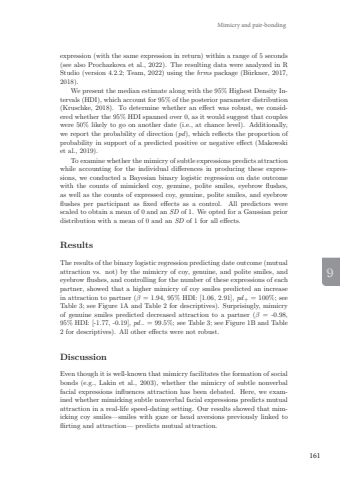Page 163 - Demo
P. 163
161Mimicry and pair-bonding9expression (with the same expression in return) within a range of 5 seconds(see also Prochazkova et al., 2022). The resulting data were analyzed in RStudio (version 4.2.2; Team, 2022) using the brms package (Bürkner, 2017,2018).We present the median estimate along with the 95% Highest Density Intervals (HDI), which account for 95% of the posterior parameter distribution(Kruschke, 2018). To determine whether an effect was robust, we considered whether the 95% HDI spanned over 0, as it would suggest that coupleswere 50% likely to go on another date (i.e., at chance level). Additionally,we report the probability of direction (pd), which reflects the proportion ofprobability in support of a predicted positive or negative effect (Makowskiet al., 2019).To examine whether the mimicry of subtle expressions predicts attractionwhile accounting for the individual differences in producing these expressions, we conducted a Bayesian binary logistic regression on date outcomewith the counts of mimicked coy, genuine, polite smiles, eyebrow flushes,as well as the counts of expressed coy, genuine, polite smiles, and eyebrowflushes per participant as fixed effects as a control. All predictors werescaled to obtain a mean of 0 and an SD of 1. We opted for a Gaussian priordistribution with a mean of 0 and an SD of 1 for all effects.ResultsThe results of the binary logistic regression predicting date outcome (mutualattraction vs. not) by the mimicry of coy, genuine, and polite smiles, andeyebrow flushes, and controlling for the number of these expressions of eachpartner, showed that a higher mimicry of coy smiles predicted an increasein attraction to partner (β = 1.94, 95% HDI: [1.06, 2.91], pd+ = 100%; seeTable 3; see Figure 1A and Table 2 for descriptives). Surprisingly, mimicryof genuine smiles predicted decreased attraction to a partner (β = -0.98,95% HDI: [-1.77, -0.19], pd− = 99.5%; see Table 3; see Figure 1B and Table2 for descriptives). All other effects were not robust.DiscussionEven though it is well-known that mimicry facilitates the formation of socialbonds (e.g., Lakin et al., 2003), whether the mimicry of subtle nonverbalfacial expressions influences attraction has been debated. Here, we examined whether mimicking subtle nonverbal facial expressions predicts mutualattraction in a real-life speed-dating setting. Our results showed that mimicking coy smiles—smiles with gaze or head aversions previously linked toflirting and attraction— predicts mutual attraction.Iliana Samara 17x24.indd 161 08-04-2024 16:36


